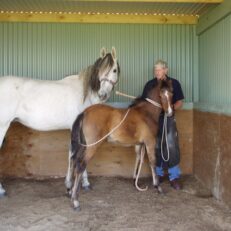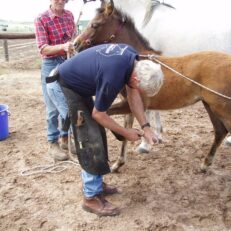STRIVING FOR HOOF CARE PERFECTION IN THE BROOD MARE
As they approach foaling, mares carry a lot of extra weight and can suffer from hoof abscesses; the greatest majority of these are totally preventable if we just know what to look for. Abscesses occur in predictable places in the hoof, either in the front part of the sole, or the bar area near the heel. Often we make the mistake of just paddock trimming the mares during the year, whereas we should realise that it is extremely important to trim the hoof for soundness whenever it’s done.
An understanding of hoof anatomy and function shows that the horse requires a concave sole, no bar pressure on the ground, no flares in the outer hoof wall and an even weight-bearing hoof wall on the ground with slightly bevelled outer edges. Invariably we tend to leave too much thickness in the … Continue Reading ››EDUCATION
Natural athletic ability is born into all horses: true or false? By the time we get to start training the young horse either on the ground or under saddle, we are sometimes quite convinced that this has to be the clumsiest animal ever bred, while the next one may appear to be totally the opposite.
The simple fact is that sadly, by the time many of our young horses are old enough to do anything with, they have had little or no attention by way of corrective hoof trimming, so we begin their education already way behind the eight ball.
To avoid this dilemma is really quite simple; we need to start looking at their legs and hooves as early as possible and be able to recognise any irregularities in the alignment of bone structures or crooked feet. We then need to begin to put in place a programme of preventative maintenance to be sure the young horse ends up with straight legs … Continue Reading ››
THE NEED TO BE PREPARED
The more I travel to assist horse owners from one end of this country to the other, the more convinced I become that there is a huge gap in the system of our horse owner education, in relation to the horse’s hoof.
Children attending pony clubs are given tuition in hoof inspection and basic care and attention of the hoof, and one would assume they carry this knowledge onto adulthood, but what about the adults who venture into the horse world for the first time?
It is your responsibility if you own or ride or care for a horse, to seek the how-to knowledge about hoof care and maintenance. Far too many horses suffer needlessly after simple mishaps such as springing a shoe or losing the odd nails while waiting for the farrier to arrive.
This situation can easily be helped if the owner just has a basic set of hoof care hand tools, and if they learn to take off a bent … Continue Reading ››
PURCHASING & MAINTAINING HOOF CARE TOOLS
TOOLS FOR DRY HOOVES IN DRY TIMES
SAFE, SECURE TRIMMING AND SHOEING
MORE TO THE SHOEING BAY
TIEING UP YOUR HORSE
There is only one way to tie up a horse while you are trimming or shoeing it and that is loosely. No matter how much you molly coddle that horse, pamper it or talk to it, your horse is a wild animal and there is just no predicting when an Afghanistan Climbing Camel is going to walk around the corner of the stall and frighten the heck out of your horse.
If you don’t want him to break his neck trying to escape from that camel, then make sure he is loosely tied. If he is serious about breaking free, he should be able to pull back and be free of the rope without taking the fence, gate or stall with him.
On one of my outback courses last year, I missed seeing that one of the participants had securely tied her horse to the rails despite my previous safety warning never to do this. Not only did he try to break free and fail, but he came down hard on my foot. During another recent course, the horses were tied to the rails while we … Continue Reading ››THE HAPPY SPOT
MY PHILOSOPHY OF THE HOOF-LINE
- The hoof/pastern angle must be parallel.
- The front of the pedal bone must be parallel with the front of the hoof wall.
- The soles must be concave and the bars dressed to be non weight bearing.
- The active tip/sole junction of the frog must be clearly identified.
- In the normal hoof, the tip of P3 can be identified and marked at 25mm forward of the active tip of the frog.
- The frog must be cleaned along its sides in a straight line back to its widest points and junction with the heel of the hoof. My reference is called the Critical Junction of the Heel.
- The cleaned sole should be concave in profile from the bottom of the sides of the frog, radiating outwards to meet the inside wall of the hoof.
- This clean sole/hoof wall junction is called the Road Map of the Hoof.
- This road map in the bottom of the hoof is the mirror image of the pedal bone within the hoof capsule and also the same profile as the normal coronary band.
- Continue Reading ››
HORSEMAN OR HORSE LOVER?
This question was thrust upon me the other day when I was asked to define the difference. Any farrier will tell you that he learns very quickly to identify these two categories of equine handlers, because the smooth transition of the day’s work and everyone’s safety depends on his instant assessment of not just the horse but also the horse owner or handler.
You may think he is just a farrier; however the need to survive has taught him to be a part-time psychologist who often resembles a contortionist with a quick mind and a good sense of humour, and with a very high pain tolerance.
A horseman is usually a competitive person or stockman who has experienced the value of training his horses to be confident and obedient, and they in return have developed a high degree of empathy and respect. The farrier can usually relax around these horses and expect not to be confronted with any sudden disasters, and thereby do … Continue Reading ››


